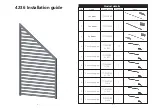
Copyright Safewaze 2023
Page 6
This equipment is intended to be used by persons trained in its correct application and use. It is the responsibility of the user to assure they are familiar with
these instructions and are trained in the correct care and use of this equipment. Users must be aware of the operating characteristics, application, limits, and the
consequences of improper use.
5.0 TRAINING
6.0 LIMITATIONS AND REQUIREMENTS
4.0 WORKER CLASSIFICATIONS
•
Capacity:
Safewaze Self Retracting Lifelines are designed in compliance with ANSI Z359.14-2021 to meet the weight capacity range of
(130-310 lbs), OSHA up to (420 lbs).
•
Anchorage:
Anchorages selected for fall arrest systems shall have a strength capable of sustaining static loads applied in the directions
permitted by the system of at least:
1. 5,000 lbs. (2267.9 kg) for non-certified anchorages, or
2. Two times the maximum arresting force for certified anchorages.
When more than one fall arrest system is attached to an anchorage, the strengths set forth in (1) and (2) above shall be multiplied by the
number of systems attached to the anchorage.
From OSHA 1926.502 and 1910.66:
Anchorages used for attachment of personal fall arrest systems shall be independent of any anchorage being used to support or suspend
platforms, and capable of supporting at least 5,000 lbs. (2267.9 kg) per user attached, or be designed, installed, and used as part of a
complete personal fall arrest system which maintains a safety factor of at least two, and is under the supervision of a qualified person.
•
Locking Speed:
The nature of this equipment requires sufficient space in the working area to allow for the SRL to lock. Working in small or confined spaces
may keep the user’s body from reaching the speed needed to lock the SRL during a fall. Working on slowly shifting materials, such as grain or sand, may not
allow the speed needed to cause the SRL to lock.
•
Swing Falls:
As the user moves laterally away from an overhead anchor point, the risks related to swing falls increase. The force of striking an object
involving swing fall can in some instances generate more forces than a fall with the user wearing no fall protection equipment. Minimize swing falls by
working as directly below the anchorage point as possible.
•
Free Fall:
Safewaze SRLs when used correctly with the unit anchored directly overhead and no slack in the lifeline, will limit the free fall distance to
0 ft. (0 m). In order to limit free fall distances, keep attachment of the SRL below Dorsal D-ring height to as minimal a distance as possible. Safewaze
Latitude Pro SRL-Ps are not
designed to allow for foot level tie-off.
•
Fall Clearance:
Figure 2 Illustrates a Fall Clearance Calculation. Fall Clearance (FC) is the total combined values of Free Fall (FF),
Deceleration Distance (DD), and a Safety Factor (SF). Safety Factor calculations may differ by manufacturer, but for the purposes of this manual,
the Safety Factor is calculated at 2 ft.. The Safety Factor includes D-ring shift and Harness Stretch.
Table 6-10 in this manual indicate Minimum Fall Clearances when the
Latitude Pro SRL-Ps
are anchored overhead, or below the Dorsal D-ring.
For falls from a kneeling or crouched position an additional 3 ft. (1 m) of Fall Clearance is required. If a Swing Fall Hazard exists, the total vertical
fall distance will be greater than if the user had fallen directly under the anchor point. Section 11 and Table 10 in this manual provide information
regarding Swing Fall hazards and additional Fall Clearance Requirements.
When installing or using this equipment always refer to the following requirements and limitations:
•
Sharp Edges:
Safewaze
Class 1 SRLs
are NOT designed for use in Leading Edge Environments. Should a specific work area have extremely sharp
edge(s) that may come into contact with the lifeline constituent of the SRL, a Class 2 SRL is required.
•
Hazards:
Extra precautions should be taken if this equipment is used in an environment where hazards exist. Hazards can include but are not limited to:
moving machinery, high voltage equipment or power lines, caustic chemicals, corrosive environments, toxic or explosive gases, or high heat. Avoid working
in an area where overhead equipment or personnel could fall and contact the user, fall protection equipment, or the lifeline. Areas where the user’s lifeline
may cross or tangle with the lifeline of another user should be avoided. Do not allow the lifeline to pass under arms or between the user’s legs.
Understand the definitions of those who work in proximity of or may be exposed to fall hazards or rescues.
Qualified Person:
“Qualified Person” means one who, by possession of a recognized degree, certificate, or professional standing, or who by extensive
knowledge, training, and experience, has successfully demonstrated his ability to solve or resolve problems relating to the subject matter, the work, or the project.
Competent Person:
“Competent Person” means one who is capable of identifying existing and predictable hazards in the surroundings or working
conditions which are unsanitary, hazardous, or dangerous to employees, and who has authorization to take prompt corrective measures to eliminate them.
Authorized Person:
“Authorized Person” means a person approved or assigned by the employer to perform a specific type of duty or duties or to be at a specific
location or locations at the job site.
It is the responsibility of a Qualified or Competent person to supervise the job site and ensure safety
regulations are complied with.






































